Langkawi Island
The island group of Langkawi consists of about a hundred limestone islands in the northwestern federal state of Kedah in Malaysia. It's still in the Strait of Malacca, closely south of the Andaman Sea and in vicinity to Satun Province in Thailand. The name of the main island is also Langkawi. The whole archipelago got World Geopark status by the UNESCO in 2007.
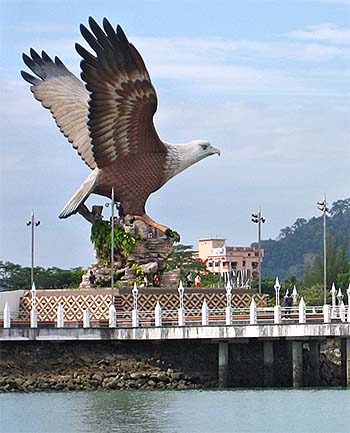
The great eagle monument near the airport. The eagle, according to one of several theories, might have been the namesgiver for the island. Image by Asienreisender, 1/2010
The main island, Pulau Langkawi, has a size of 320km2 by an extension of 25km in north-south distance and a bit more in east-west, the total of all islands measures about 478km2. It's about 30km from the mainland Malay Peninsula, opposing Perlis and Satun. I'll focus here on Langkawi main island, which interiour is coined by limestone mountains, of which the highest peak, Gunung Raya, reaches 890m. Roughly two thirds of the island is covered with tropical rainforest. The eastern shores are overgrown with mangrove forests. Other parts of the coastline form flat, alluvial sand beaches or plains, interrupted by limestone rocks.
These limestone formations, who coin great parts of the coastal regions of the Andaman Sea, are several hundred million years old. Here, in Langkawi, they are the oldest of them all, older than 500 million years, and date back to the Cambrian period in earth's history.
Langkawi's climate is coined by the monsoon cycle, which means here a long rainy season and a short dry season, which lasts only from December to February.
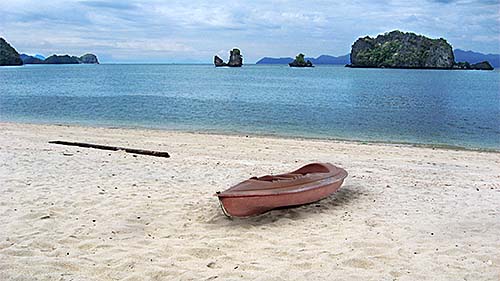
One of Langkawi's beaches. Image by Asienreisender, 1/2010
The population is similarly to that of Malaysia in general, with the self-called bumiputra (sons of the earth, the muslim Malay majority), the influential Chinese minority, a smaller Indian minority and, in divergence to most other parts in the country, a Thai minority and some 'sea gypsies' (called here orang laut, 'people of the sea', see also: 'The Moken of Thailand and Burma'). Langkawi Island has a population of roughly 65,000 souls. The biggest town is Kuah.
Langkawi's economy is coined by tourism; the number of visitors in 2012 was around three millions.
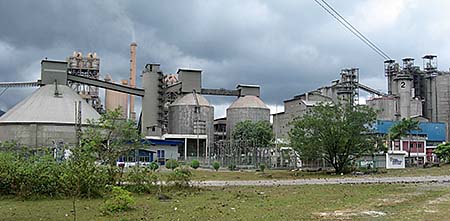
The ugly monster is to feed the ever hungry construction sector. Image by Asienreisender, 1/2010
The traditional agriculture is still alive (much rice cultivation). Besides, and that's always stressed here, Langkawi is a duty-free island. One can buy cheap alcohol here, unlike it is in Malaysia. A number of attractions are offered for tourists, who contribute their harm to the environment. Particularly remarkable is the sky-bridge, a hanging bridge in 687m height with two visitor platforms who grand a great view over the islands and the sea. Accessible is the sky-bridge by a cable-car, at which base is a completely artificial touristic village placed (called Oriental Village).
The infrastructure on the island is good, as it is in all urbanized parts of peninsular Malaysia. Nevertheless, there is a bad lack of public transport. Ferries connect Langkawi with Penang, Alor Setar and Satun (Thailand). Another ferry goes to the Malaysian federal state Perlis. There is an international airport on the main island. At the north coast is an industrial port placed, accompanied by a huge, ugly concrete factory.
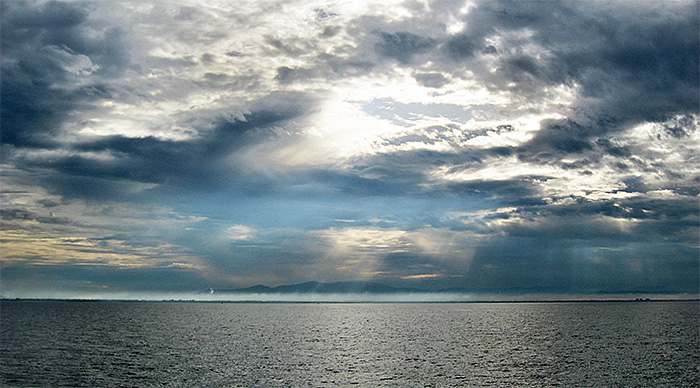
Langkawi Island Group, seen from the south. Image by Asienreisender, 1/2010
Langkawi has no long history; over the last centuries it was often close to the sultanate of Kedah. Among the first who left a record of Langkawi was a Chinese expedition; there is even a Chinese map handed down from the time. In the 15th and 16th century, Pulau Langkawi was known as a pepper island.
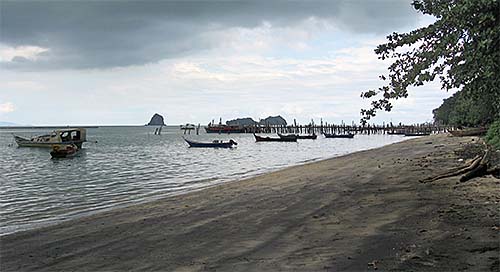
Part of the island's sand beaches are black. Image by Asienreisender, 1/2010
Since unknown times Langkawi is home for the sea people. It had also the recommendation for being a base for pirates. There is a long-time Siamese influence on the islands as well. Probably already the kingdom of Ayutthaya showed presence here, as they did further south as well. In 1821 there was a Siamese invasion in which the islands were captured and kept until 1837. The greatest part of the population fell victim then to deportation and slavery in other parts of Ayutthaya. Resettlement happened by immigrants from Sumatra. Alltogether it seems that Langkawi was Siamese for the longest part of the 19th century, until a treaty with Britain forced it to be handed over to the European colonial power, forming the border as it is today between Malaysia and Thailand. Only in the Second World War the Thai took over control again for some three years. When Britain retreated from Malaysia in 1957, the island became part of Kedah state in Malaysia.